

Is Earth Running Out Of Crust? Want to stay on top of all the space news?
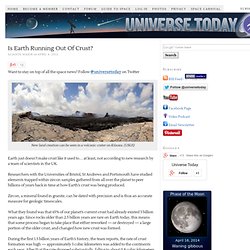
Follow @universetoday on Twitter New land creation can be seen in a volcanic crater on Kilauea. (USGS) Earth just doesn’t make crust like it used to… at least, not according to new research by a team of scientists in the UK. Researchers with the Universities of Bristol, St Andrews and Portsmouth have studied elements trapped within zircon samples gathered from all over the planet to peer billions of years back in time at how Earth’s crust was being produced. Zircon, a mineral found in granite, can be dated with precision and is thus an accurate measure for geologic timescales. What they found was that 65% of our planet’s current crust had already existed 3 billion years ago. During the first 1.5 billion years of Earth’s history, the team reports, the rate of crust formation was high — approximately 3 cubic kilometers was added to the continents each year.
Stop-and-go Plate Tectonics. Primeval Precipitation: What Fossil Imprints of Rain Reveal about Early Earth. Fossil Raindrops Reveal Early Atmosphere. In ancient Earth history, the Sun burned as much as 30 percent dimmer than it does now.
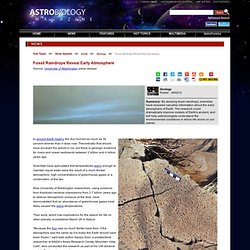
Theoretically that should have encased the planet in ice, but there is geologic evidence for rivers and ocean sediments between 2 billion and 4 billion years ago. Scientists have speculated that temperatures warm enough to maintain liquid water were the result of a much thicker atmosphere, high concentrations of greenhouse gases or a combination of the two. Now University of Washington researchers, using evidence from fossilized raindrop impressions from 2.7 billion years ago to deduce atmospheric pressure at the time, have demonstrated that an abundance of greenhouse gases most likely caused the warm temperatures.
Their work, which has implications for the search for life on other planets, is published March 28 in Nature. Knowing the atmospheric pressure of a given period can help scientists understand in better detail the overall nature of the atmosphere at that time. Antimatter belt around Earth discovered by Pamela craft. 7 August 2011Last updated at 10:54 The antiprotons lie sandwiched between the inner and outer Van Allen belts (in red) around the Earth A thin band of antimatter particles called antiprotons enveloping the Earth has been spotted for the first time.
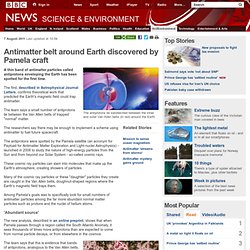
The find, described in Astrophysical Journal Letters, confirms theoretical work that predicted the Earth's magnetic field could trap antimatter. The Earth, shaped by gravity, is anything but round. The saying that beauty is in the eye of the beholder means that what we see is subject to our perspective. Take our planet for example. From space through human eyes or a camera, it seems to be a beautiful uniform sphere, but that’s not how the European Space Agency’s ( ESA ) GOCE satellite sees it. In fact, looking through its eyes you would have to say that Earth looks more like a potato. GOCE was launched in March 2009 with the mission to map the small differences in our planet’s gravity . It does this through its gradiometer which consists of six highly sensitive accelerometers that measure gravity in 3D.
Using data that the satellite has collected over the last 12 months, scientists have been able to construct what is referred to as a geoid. Earth Formed from Diverse Meteorite Mix. Earth's building blocks were more eclectic than once thought, according to a new study suggesting our planet formed from collisions of many different types of meteorites.
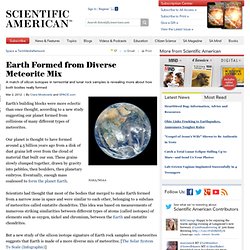
Our planet is thought to have formed around 4.5 billion years ago from a disk of dust grains left over from the cloud of material that built our sun. These grains slowly clumped together, drawn by gravity into pebbles, then boulders, then planetary embryos. Eventually, enough mass coalesced to form the planet Earth. Haze clears on ancient Earth's early atmosphere - environment - 19 March 2012. London's famous smogs were nothing compared with the thick haze that enveloped Earth 2.5 billion years ago.

The atmosphere at the time was rich in hydrocarbons, similar to that of Saturn's moon, Titan, today. Just before the atmosphere ditched methane and began accumulating oxygen, though, it appears to have flipped back and forth between its hydrocarbon haze and clear skies. About 2.4 billion years ago, photosynthesising microbes had at last made enough oxygen for it to accumulate in the atmosphere. Earth Took A Multibillion-year Beating. It’s no secret the early Earth took a beating from above, but now it seems the planet sustained a longer bombardment than initially thought.

Tiny beads formed by enormous impacts tell the story of Earth’s multibillion-year bombardment from above. The ages of these impact spherules, like those pictured in this sample from Western Australia, point toward the conclusion that large asteroids hit the Earth for much longer than scientists initially thought. Bruce M. Earth Has Less Water Than You Think.
Want to stay on top of all the space news?

Follow @universetoday on Twitter All the water on Earth would fit into a sphere 860 miles (1,385 km) wide. (Jack Cook/WHOI/USGS) Getting a Handle on How Much Cosmic Dust Hits Earth. Want to stay on top of all the space news?
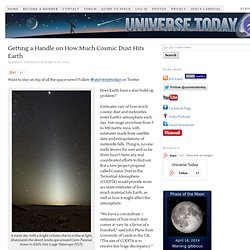
Follow @universetoday on Twitter A starry sky, with a bright column due to zodiacal light, illuminates the desert landscape around Cerro Paranal, home to ESO's Very Large Telescope (VLT). Does Earth have a dust build-up problem? Estimates vary of how much cosmic dust and meteorites enter Earth’s atmosphere each day, but range anywhere from 5 to 300 metric tons, with estimates made from satellite data and extrapolations of meteorite falls. Thing is, no one really knows for sure and so far there hasn’t been any real coordinated efforts to find out.
Should we be worried about Earth's magnetic poles reversing? The end of the world as we know it could come in any number of ways, depending on who you ask.

Some people believe global cataclysm will occur when Earth's magnetic poles reverse. When north goes south, they say, the continents will lurch in one direction or the other, triggering massive earthquakes, rapid climate change and species extinctions. Is Earth Alive? Scientists Seek Sulfur For An Answer. Want to stay on top of all the space news?
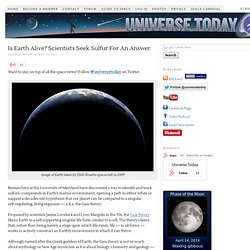
Follow @universetoday on Twitter Image of Earth taken by ESA's Rosetta spacecraft in 2009 Researchers at the University of Maryland have discovered a way to identify and track sulfuric compounds in Earth’s marine environment, opening a path to either refute or support a decades-old hypothesis that our planet can be compared to a singular, self-regulating, living organism — a.k.a. the Gaia theory. Proposed by scientists James Lovelock and Lynn Margulis in the 70s, the Gaia theory likens Earth to a self-supporting singular life form, similar to a cell.
The theory claims that, rather than being merely a stage upon which life exists, life — in all forms — works to actively construct an Earthly environment in which it can thrive. Once called the Gaia hypothesis, enough scientific cross-disciplinary support has since been discovered that it’s now commonly referred to as a theory. Sulfur is a key element in both organic and inorganic compounds.